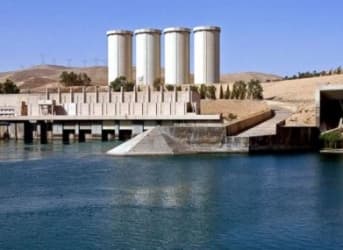Hydroelectric dams are a nifty way of producing a huge amount of power, but they do not last forever. This is a tale of two dams that will fail unless they are urgently repaired, and if they fail, catastrophic suffering and loss of life will be the result.
The first is the Mosul Dam, which stretches across the Tigris River in a valley north of Mosul, Iraq. As dams go, this one is a civil engineering horror. The dam was captured on Aug. 7 by the Islamic State, and retaken 10 days later by Iraqi and Kurdish forces, with American air support.
Should the two-mile-wide dam fail, which is likely, Mosul would be wiped out and the damage would extend to Baghdad. Loss of life could reach 500,000, and millions could be deprived of water and power: an immense catastrophe piled on the daily pain of Iraq.
The second dam, in southern Africa on the Zambezi River, is the Kariba. This 55-year-old dam, by some measures, is the world’s second largest. It was a civil engineering masterpiece and has held up well, given the spotty maintenance by its owners – Zambia, on the north bank and Zimbabwe, on the south bank.
But the Kariba Dam is predicted to fail within three years unless it undergoes massive repair. If it does, surging water would rip a vast trench down the length of the Zambezi River on its route to the Indian Ocean. The wall of water would take out another giant dam, Cahora Bassa, in Mozambique.
Loss of life could reach 3.5 million, with untold damage to wildlife. South central Africa would lose 40 percent of its electric supply.
While the Mosul and Kariba dams share the same potential lethality, they are very different structures.
The Mosul Dam was a rush job, ordered by Saddam Hussein in the 1980s without regard to the engineering realities of the site. It is anchored in gypsum, which dissolves in water. Daily, leaks in the foundation have to be plugged with grout -- a mixture of cement and sand. The U.S. Army Corps of Engineers said the Mosul Dam is fundamentally the wrong structure for the location, and called it the “most dangerous dam in the world.”
Even with careful tending, the Mosul Dam is in danger. According to a report in The Wall Street Journal, many of the workers who have kept the dam operating fled when fighters from the Islamic State arrived on the scene. Only one dedicated manager is known to have stayed.
The United States has spent $33 million trying to stabilize the Mosul Dam, but the money, according an inspector general’s report, was largely wasted. Now, the U.S. bombing campaign is threatening to further destabilize an already fragile structure.
Apart from general maintenance issues, the Kariba Dam’s problems are a little simpler. When the dam was built between 1955 and 1959, the plan was to control the river’s flow though six sluice gates set in the wall. The water travels through the sluices and empties into a plunge pool before flowing downstream.
The trouble is that the plunge pool has grown from an indentation in the riverbed to a vast 285-foot-deep crater. The water, which swirls around inside it with great force, is eroding the basalt rock on which the dam is anchored. In other words, the dam is eating itself alive. Engineers dare not open all the sluice gates at once – the last time they did was in 1966.
The necessary fix is a combination of blasting an enlarged plunge pool so the water moves along without creating a whirlpool, and injecting grout -- in the form of underwater concrete -- to shore up the foundation.
A consortium of the World Bank, the European Union and the African Development Bank this month agreed to provide $250 million to save Kariba. Engineers say the work must be done in the next three years or it will be too late.
If Zimbabwe and Zambia can agree on the contracts, work should begin next year. But in that part of the world, the only thing that moves fast is the Zambezi River.
Considering the chaos that has befallen Iraq, the outlook for the Mosul Dam is anyone’s guess.
By Llewellyn King
Llewellyn King is executive producer and host of "White House Chronicle" on PBS. His e-mail is lking@kingpublishing.com.


















